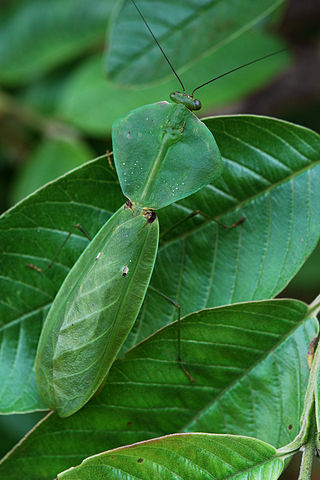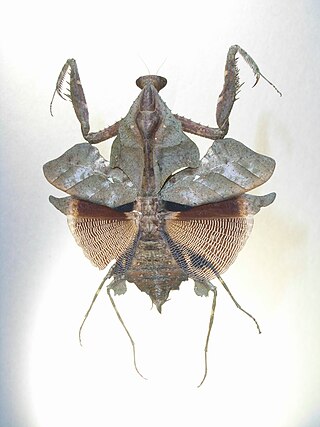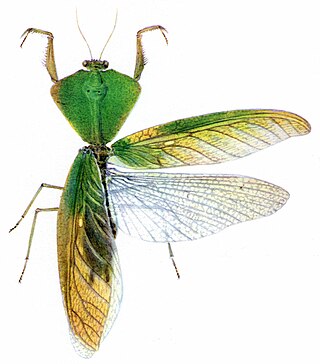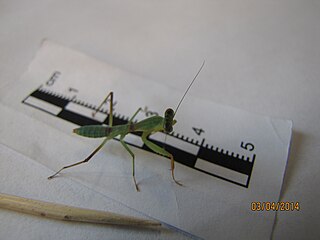
Choeradodis is a genus of praying mantises with common names such as shield mantis, hood mantis, and leaf mantis because of their extended, leaf-like thoraces. The distinguishing characteristic of Choreododis from which it takes its common names is a laterally expanded thorax. This adaptation for the purpose of camouflage, as well as a rounded wing case and a habit of staying relatively flattened, aid its leaf mimicry.

Phyllocrania paradoxa, common name ghost mantis, is a small species of mantis from Africa remarkable for its leaf-like body. It is one of the three species in the genus Phyllocrania. It is known for its distinct and exclusive camouflaged appearance of a dry weathered leaf.
Deroplatys desiccata, known by the common name giant dead leaf mantis, is a praying mantis from Southeast Asia. This is the type species of genus Deroplatys.

Deroplatys lobata, common name Southeast Asian dead leaf mantis or dead leaf mantis, is a species of praying mantis that inhabits Thailand, Java, Borneo, Indonesia, Sumatra and the Malay Peninsula.

Hierodula is a genus of praying mantids in the tribe Hierodulini, found throughout Asia. Many species are referred to by the common name giant Asian mantis because of their large size compared to other mantids. Their large size and vibrant coloration make Hierodula mantids popular in the pet trade. Some widespread species include H. membranacea and H. patellifera; however this has been considered a 'catch all' genus and is currently subject to review. In 2020, three species were moved to a new genus, Titanodula.

Dead leaf mantis is a common name given to various species of praying mantis that mimic dead leaves. It is most often used in reference to species within genus Deroplatys because of their popularity as exotic pets. Examples include D. desiccata, D. lobata, and D. philippinica. Other species to which the term may apply include Acanthops falcataria, A. falcata, and Phyllocrania paradoxa.

Choeradodis rhomboidea, common names tropical shield mantis, hood mantis, and leaf mantis, is a South American species of praying mantis, restricted to the Amazon and Guiana Shield.

Choeradodis stalii is a species of praying mantis with common names that include tropical shield mantis, hooded mantis, and leaf mantis. It is found in Brazil, Ecuador, French Guiana, Panama, and Peru.

Choeradodis rhombicollis, or Peruvian shield mantis, is a species of praying mantis native to North America, Central America, and South America. It is found in Belize, Costa Rica, Ecuador, French Guiana, Guatemala, Colombia, Mexico, Nicaragua, Panama, Peru, and Suriname.

Leaf mantis is a common name for certain praying mantises including:

Shield mantis, hood mantis and leaf mantis are common names for certain praying mantises with an extended thorax aiding it in camouflage and leaf mimicry. The terms are used for species in the following genera:

Rhombodera is a genus of praying mantises native to Asia and possessing common names such as shield mantis, hood mantis, and leaf mantis because of their extended, leaf-like thoraxes.

Tamolanica is a genus of praying mantises native to Asia. They have common names such as shield mantis, hood mantis, and leaf mantis because of their extended, leaf-like thoraxes. The following species are recognised in the genus Tamolanica:
Boxer mantis is a common name given to various species of praying mantis. The name comes from the way these mantises move their oversized grasping forelimbs as they communicate with each other.

Bark mantis is a common name given to various species of praying mantis, especially those with cryptic camouflage resembling tree bark. Examples include:

Acanthops is a genus of mantises in the family Acanthopidae, containing 20 species that can be found in Central and South America.

Rhombodera valida is a species of praying mantises in the family Mantidae, found in Indomalaya.

Asiadodis squilla is a species of praying mantis in the family Mantidae. It is the native to India and Sri Lanka, and it is the type species for the genus Asiadodis.
Giant mantis may refer to:
















